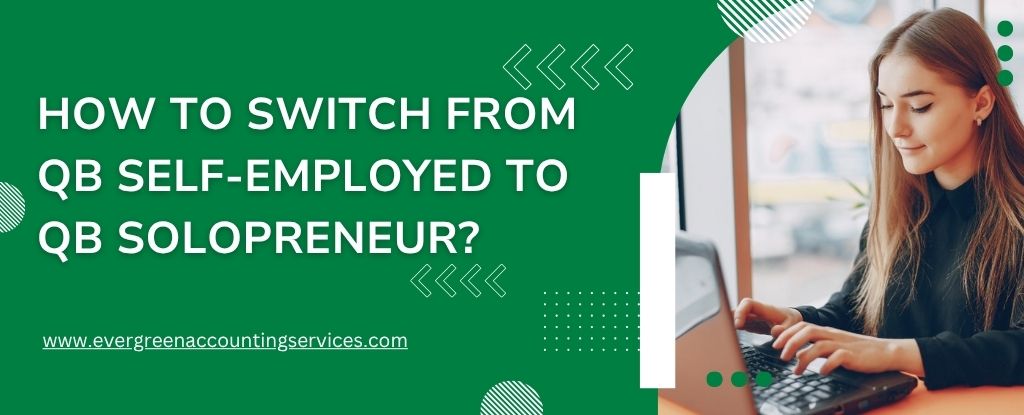Table of Contents
ToggleAre you ready to upgrade your financial toolkit? Transitioning from QuickBooks Self-Employed to QuickBooks Solopreneur offers enhanced features tailored for modern self-employed professionals. This guide will walk you through every step of the migration process, ensuring your business data stays safe and you enjoy a smoother, more powerful accounting experience.
Why Switch to QuickBooks Solopreneur?
QuickBooks Solopreneur is designed specifically for freelancers, consultants, and other self-employed individuals who need more robust tools to manage their finances. While it maintains many familiar features, it also introduces advanced functionalities such as:
- Customizable estimates
- Financial goal setting
- TurboTax integration
- Enhanced reporting tools
With this upgrade, managing your finances becomes more intuitive, insightful, and efficient.
What Data Transfers Automatically?
When you make the switch, most of your existing data will migrate automatically, so you can continue running your business with minimal interruptions. Here’s what moves over seamlessly:
- Customer details
- Invoices (for accounts using the new invoice experience)
- Mileage and trips
- Products and services
- Connected bank accounts
- Transactions (up to 3 years)
- Uploaded receipts
These elements ensure continuity in your bookkeeping and allow you to hit the ground running with your new software.
Data Not Yet Supported for Migration
There are a few types of data that QuickBooks is still working on supporting in the future:
- Banking rules
- Quarterly tax estimates
If these are critical to your workflow, consider waiting until these elements are available for migration. Otherwise, you might need to manually input or recreate them in your new account.
Data That Cannot Be Migrated
Some information is incompatible with QuickBooks Solopreneur and must be re-added or managed manually:
- Third-party app integrations (e.g., Etsy, Uber, Amazon)
- Vendor information
- Tags used for categorization
Be sure to document or export this data before switching so you can reference it later if needed.
Steps for Automatic Upgrade to QuickBooks Solopreneur
If you’re ready to upgrade directly from your QuickBooks Self-Employed account, follow these simple steps:
1. Save and Download Reports
Before switching, download all reports, receipts, transactions, and mileage logs. This step is crucial because you will lose access to your Self-Employed account after upgrading.
2. Start the Upgrade Process
- Log into your QuickBooks Self-Employed account.
- Click on the Settings gear icon, then choose Upgrade.
- Under the QuickBooks Solopreneur column, click Choose Plan.
- Review the differences in features, then click Continue.
3. Backup Your Data
If prompted, download your data again to ensure nothing is lost. You’ll be redirected to the Reports section to do this.
4. Proceed with Migration
Click Continue, then Get Started. You may be asked to confirm or update your business details. Once completed, you’ll be directed to your new QuickBooks Solopreneur dashboard.
Manual Migration Process to QuickBooks Solopreneur
Prefer a more hands-on approach or want to start fresh? Here’s how to manually switch to QuickBooks Solopreneur:
Step 1: Export Your Existing Data
Export all relevant data from your QuickBooks Self-Employed account, including:
- Bank transactions
- Expense receipts
- Income and sales data
- Mileage logs
Store this information in a secure location as your financial record backup.
Step 2: Subscribe to QuickBooks Solopreneur
Head to the official QuickBooks website and navigate to the Plans & Pricing page. Choose and subscribe to the QuickBooks Solopreneur plan.
Step 3: Import Data Into Your New Account
Connect your bank and credit card accounts to import transactions automatically, or upload them manually via CSV files.
This is also a good time to re-enter important items such as customers, products, and services.
Step 4: Cancel QuickBooks Self-Employed
Once you’ve verified that your data has been successfully migrated, cancel your old subscription to avoid double billing.
Access QuickBooks Solopreneur On the Go
Stay connected to your business from anywhere by using the QuickBooks mobile app. It’s available for download on:
With mobile access, you can track expenses, send invoices, and monitor your cash flow anytime, anywhere.
Final Thoughts
Switching from QuickBooks Self-Employed to QuickBooks Solopreneur is a smart move for self-employed professionals ready to scale and optimize their financial management. With enhanced tools, broader reporting capabilities, and seamless bank integrations, QuickBooks Solopreneur helps you gain deeper insight into your business finances—while saving time and effort.
Take control of your business’s future today with QuickBooks Solopreneur.
Frequently Asked Questions
While they serve similar purposes, QuickBooks Solopreneur is a newer offering and not identical to QuickBooks Self-Employed. There are some differences in features and design.
To stop using QuickBooks Self-Employed, you’ll need to cancel your subscription through your account settings.
QuickBooks Solopreneur has its own pricing structure. You can check the current subscription cost on the official QuickBooks website.
Yes, QuickBooks Solopreneur is available as a mobile app, making it easy to manage your finances on the go.
QuickBooks Self-Employed is being phased out and replaced with QuickBooks Solopreneur, which offers updated features and a new user experience.


